Briefing on Arctic and Antarctic sea ice - August 2023
Alex West and Ed Blockley
Summary
- Arctic sea ice extent is currently 9th lowest on record for the time of year.
- Extent is particularly low in the Beaufort, Laptev, and East Siberian Seas.
- July saw an occurrence of the Arctic Dipole weather pattern, with anticyclonic weather on the North American side of the Arctic and cyclonic weather on the Siberian side. This weather pattern has been associated with severe sea ice loss in the past but has not yet resulted in unusually high sea ice loss this year.
- Uncertainty in September extent remains high; an extent between 3rd – 17th lowest is most probable.
- Antarctic sea ice remains exceptionally low, the lowest on record for the time of year by a wide margin, as has been the case since early June.
Current Arctic sea ice extent
Arctic sea ice extent on 9th August 2023 was 6.06 million sq km. This was 1.48 million sq km below the 1981-2010 average, and was the 9th lowest extent on record for this date, the lowest having been 5.09 million sq km in 2012.
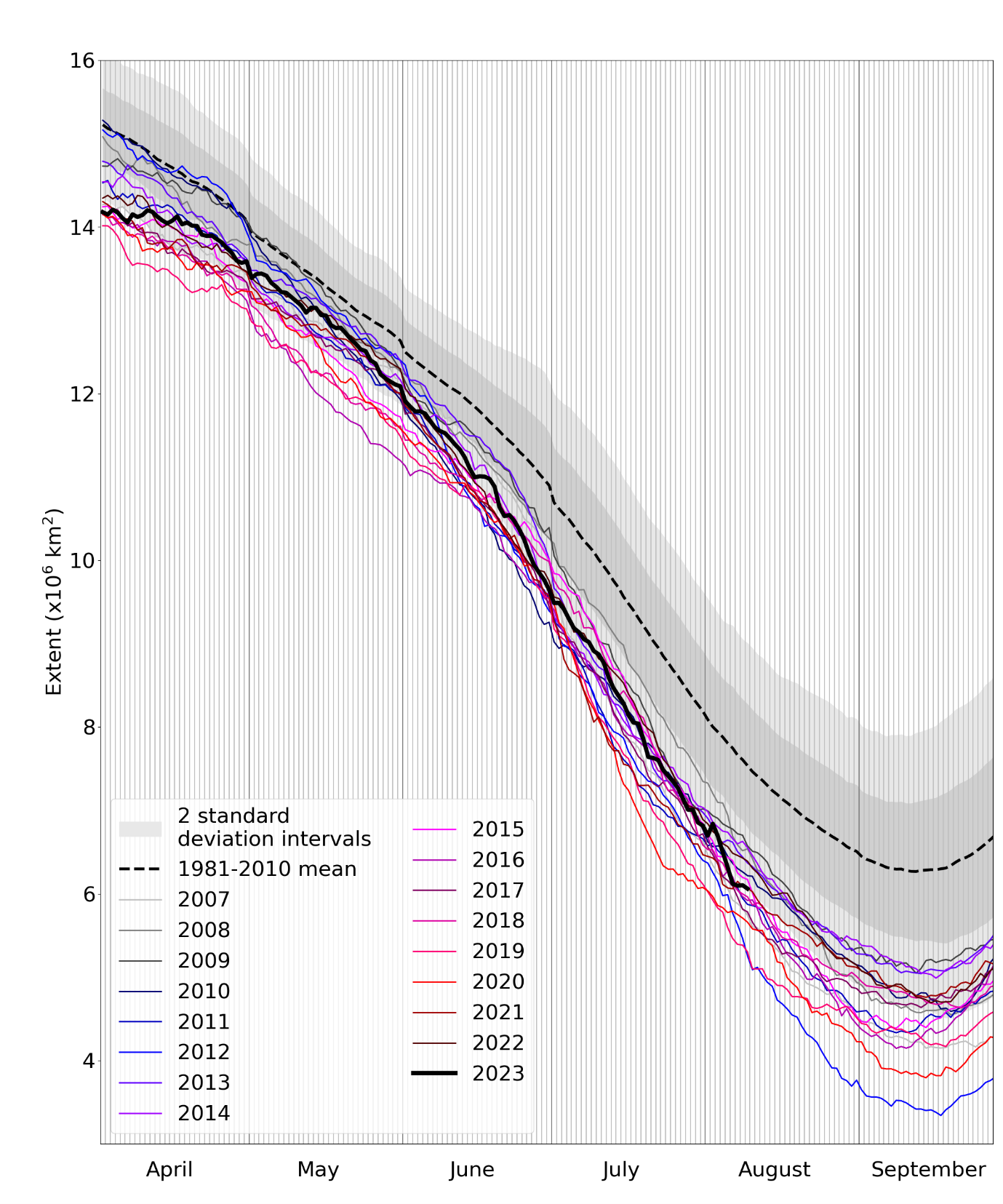
Figure 1. Daily Arctic sea ice extent for 2023, compared with recent years and the 1981-2010 average with ± 1 and 2 standard deviation intervals indicated by the shaded areas. Data are from the National Snow and Ice Data Center (NSIDC).
Extent was well below average in all regions of the Arctic except the Barents Sea, and in a region between the Chukchi and East Siberian Seas where an ‘arm’ of ice extended from the main ice pack towards the Siberian coast. Satellite measurements indicated that ice concentration within this arm may have been rather low, although uncertainty in ice concentration is large in summer as satellites struggle to distinguish open water from melt ponds on the ice surface.
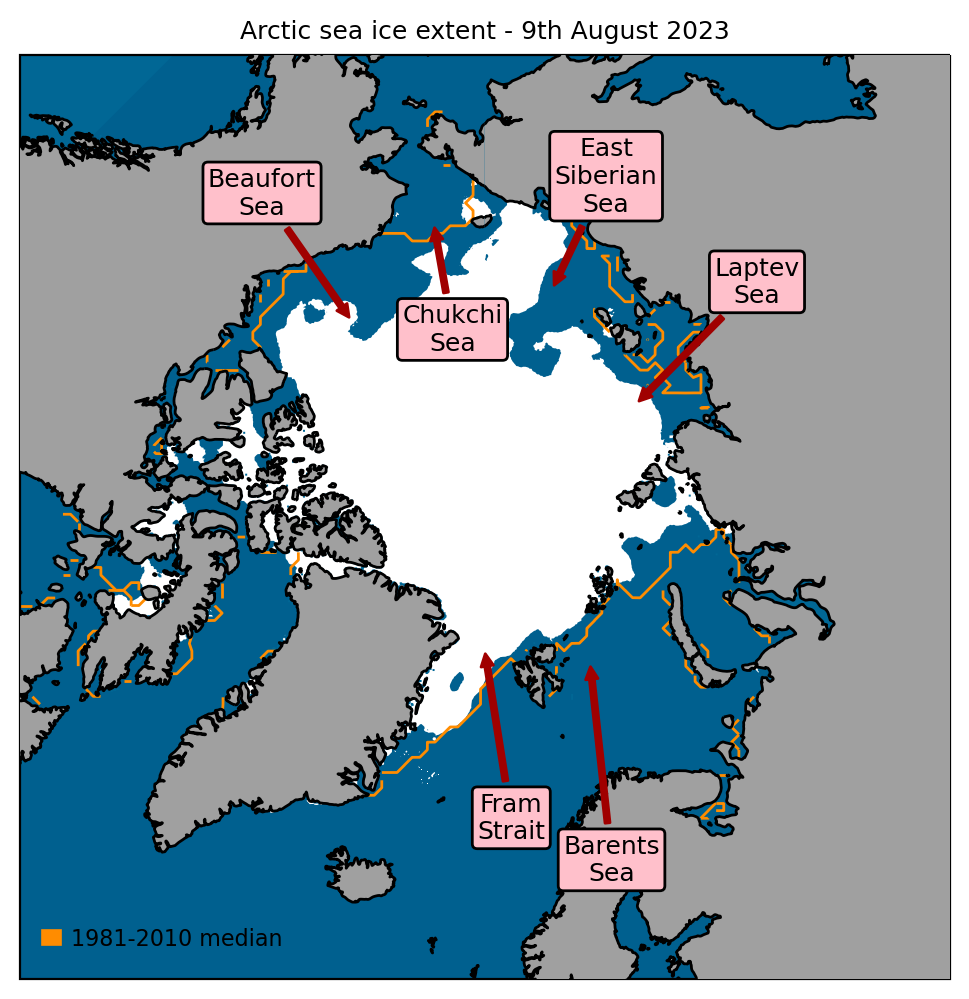
Figure 2. Arctic sea ice extent on 9th August 2023, with 1981-2010 average extent indicated in orange, and the regions referred to in the text labelled. Data are from EUMETSAT OSI SAF (Tonboe et al., 2017).
Arctic: July 2023 in context
Average Arctic sea ice extent for July 2023 was 8.18 million sq km according to the NSIDC Sea Ice Index (Fetterer et al., 2017). This was 1.29 million sq km below the 1981-2010 average, but 0.64 above the long-term linear trend (Figure 3).
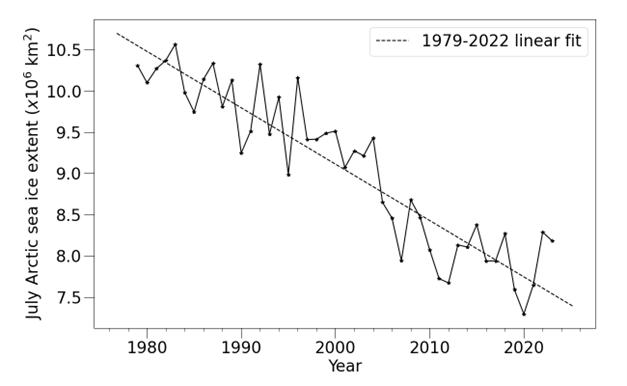
Figure 3. Average July Arctic sea ice extent according to the NSIDC Sea Ice Index (Fetterer et al., 2017).
The average rate of sea ice melt in July 2023 was 91,000 sq km per day. This was slightly above the 1981-2010 average rate of 86,000 sq km per day. The highest ever July average melt rate of 108,000 sq km per day was recorded in 2020.
Arctic weather in July 2023 was dominated by high pressure (settled weather) over the North American side of the Arctic and low pressure (stormy weather) over the Siberian side of the Arctic (Figure 4a). This circulation pattern, known as the Arctic Dipole, has often been associated with the most severe Arctic sea ice melt in the past, most notably in 2007 (Wang et al., 2009). The combination of the two pressure systems channels mild air from the midlatitudes across the Arctic, and directly blows sea ice out through the Fram Strait. Consistent with this, large areas of the Arctic Ocean saw much warmer than average temperatures in July 2023, with the southeastern Beaufort Sea more than 7°C above average (Figure 4b), although the Laptev Sea saw colder than average temperatures.
It remains to be seen whether the persistent Arctic Dipole of July will cause an unusually low sea ice minimum in September. As noted above, rates of ice extent loss in 2023, while above average, have not been exceptional. However, ice area loss rates have been much higher than average across most of the Arctic Pacific sector (Figure 4c) resulting in rather low sea ice concentration, which may render this region more vulnerable to melting later in the season. Ice loss from 1st – 9th August has been above the 1981-2010 average but well below record high levels.
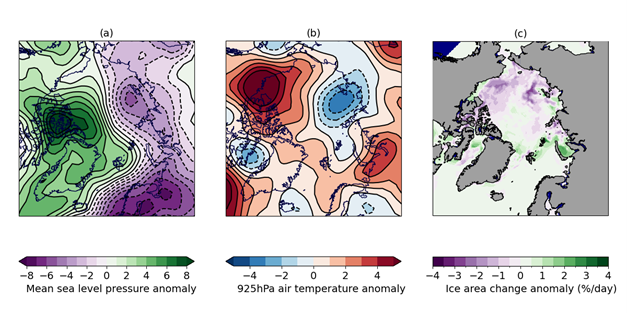
Figure 4. July 2023 anomaly relative to the 1981-2010 average in (a) sea level pressure; (b) 925hPa temperature; (c) average daily sea ice area change. Sea level pressure and temperature data are from the NCEP reanalysis (Kalnay et al., 1996). Ice concentration data are from EUMETSAT OSI SAF (Tonboe et al., 2017). For the sea ice area change, green areas indicate slower than average loss while purple areas indicate faster than average loss. Ice loss may be exaggerated at this time of year due to the formation of melt-ponds on the ice surface, which satellite sensors struggle to distinguish from open water.
Outlook for September
Uncertainty in September sea ice extent is still quite high at this point in the melt season, as Arctic weather continues to exert a strong influence on the sea ice melt rate through August and into early September. While there is no indication from sea ice melt rates that a new record low September extent is likely, the presence of the Arctic Dipole in July may have rendered the sea ice more vulnerable than usual to further melting. It is very likely that this year will see a continuation of the post-2007 sea ice conditions, whereby every year since 2007 (inclusive) has recorded a September extent lower than every year before 2007.
Each year, scientific centres around the world submit predictions of September Arctic sea ice extent to the Sea Ice Outlook (SIO), a series of reports published in June, July and August by the Sea Ice Prediction Network (SIPN). The second report of the summer was published on 25th July and comprises 30 predictions of September sea ice extent, with a median of 4.66 million sq km. The range of predictions remains high at 3.12 to 5.31 million sq km, but the interquartile range is much narrower at 4.51 to 4.80 million sq km (Figure 5); the lowest prediction is an outlier, with the next lowest at 3.89 million sq km. Only the lowest prediction would represent a new record low September sea ice extent, although two predictions have uncertainty ranges that include this possibility. All SIO predictions predict a September extent lower than observed for any year prior to 2007.
To supplement the SIO predictions, we use three different statistical methods to illustrate the range of September average sea ice extents that are likely given current data, all of which are illustrated in Figure 5 alongside the SIO predictions:
- Extrapolation of the 1979-2022 linear trend produces a predicted September average extent of 4.19 ± 1.04 million sq km.
- There is good correlation between September average ice extent and average ice extent from 26th July – 9th August (the most recent 15 days of available data at the time of writing). Applying standard statistical methods to this relationship produces a predicted September average extent of 4.82 ± 0.55 million sq km. This is consistent with a September extent in the range 4th – 17th lowest.
- A range of plausible September sea ice extents is obtained from the average sea ice extent from 5th – 9th August, by subtracting the daily melting rates observed in the years 2007-2022 from this point until September. This method produces a predicted range of September sea ice extents from 4.26 to 5.08 million sq km, consistent with a September extent in the range 3rd – 14th lowest.
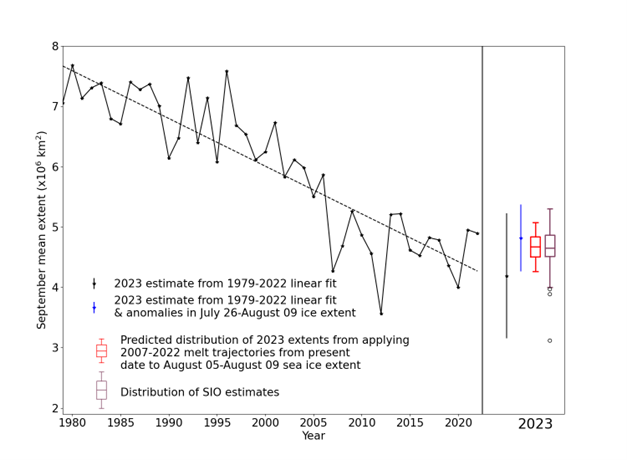
Figure 5. September Arctic sea ice extent since satellite records began in 1979 from the NSIDC Sea Ice Index (Fetterer et al., 2017), with SIPN Sea Ice Outlook and statistical predictions for September 2023. For the statistical predictions derived from linear fit, error bars represent twice the standard deviation of September mean ice extent about the trend lines with respect to which the estimates are taken. The range of predictions derived from past melting trajectories is shown as a red boxplot indicating range, median and quartiles of estimates derived from each trajectory in the 2007-2022 period. The Sea Ice Outlook is shown as a purple boxplot indicating range, median and quartiles of the 38 predictions submitted.
Current Antarctic sea ice extent
Antarctic sea ice extent on 9th August 2023 was 14.98 million sq km. This was the lowest on record for the time of year by a very large margin, the next lowest having been 16.42 million sq km in 1986. The 2023 figure was 2.50 million sq km below the 1981-2010 average.
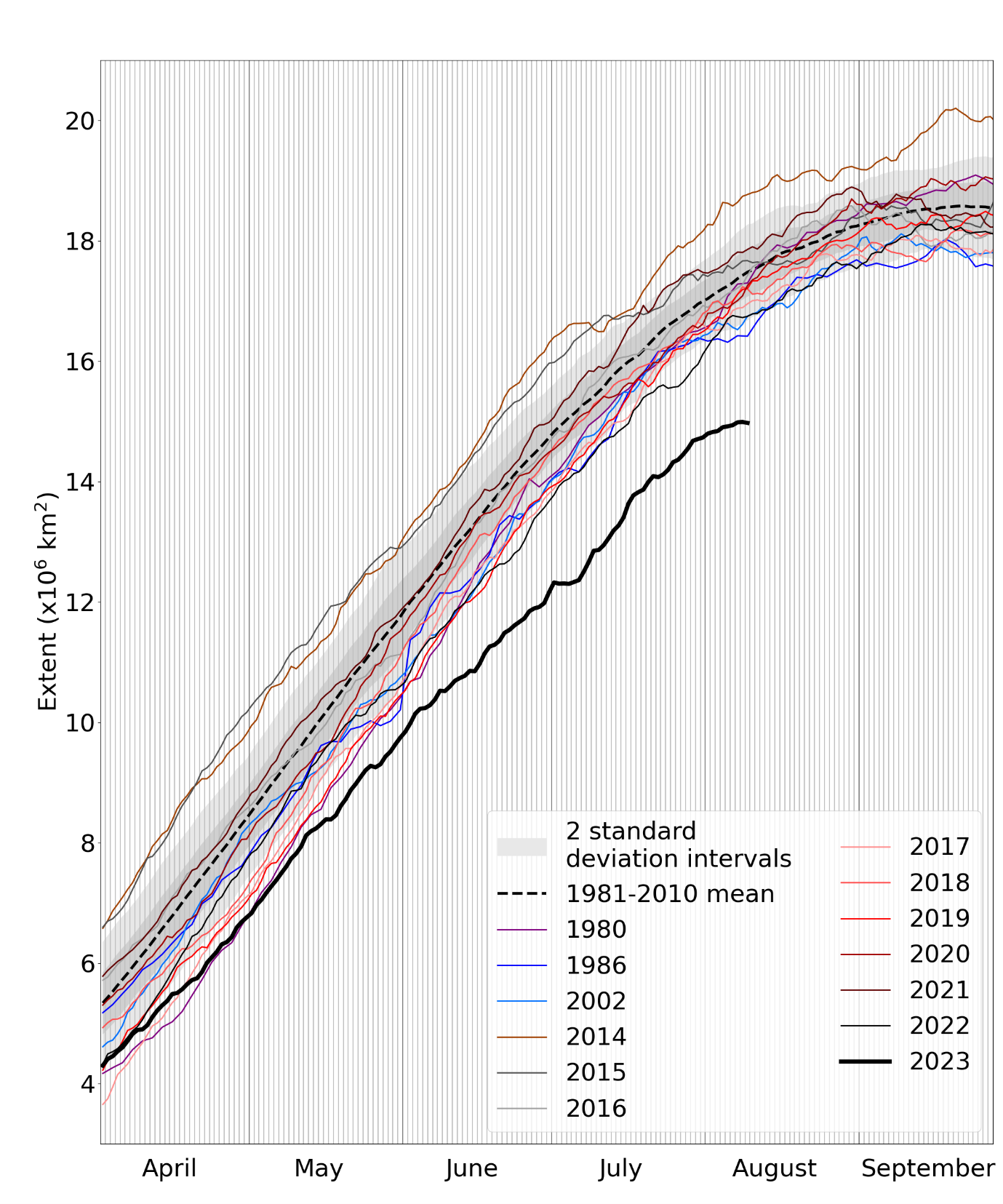
Figure 6. Daily Antarctic sea ice extent for 2023, compared with recent years, selected other low ice years, and the 1981-2010 average, with ± 1 and 2 standard deviation intervals indicated by the shaded areas. Data are from NSIDC.

Figure 7. Antarctic sea ice extent on 9th August 2023, with 1981-2010 average extent indicated in orange, and the regions referred to in the text labelled. Data are from EUMETSAT OSI SAF (Tonboe et al., 2017).
Extent was well below average in all sectors of the Antarctic except for the Amundsen Sea, where extent was well above average, and in the eastern part of the Indian Ocean sector where it was near-average. Extent was particularly low in the Ross Sea.
Antarctic sea ice extent has been at record low levels for the time of year since mid-May. Since 5th June extent has been continuously more than 2 million sq km below the 1981-2010 average; from 23rd June – 15th July it was more than 2.5 million sq km below average (Figure 8). Over this period, the location of the lowest sea ice extent (relative to average) has changed somewhat. Earlier in the season extent was particularly low in the Bellingshausen and western Weddell Seas near the Drake Passage, while in recent weeks extent has been lowest in the Ross Sea and in the eastern Weddell Sea. A change in atmospheric circulation is likely responsible. Whereas May and June were dominated by low pressure in the Amundsen Sea, directing warm northerly winds over a large part of the sea ice edge near the Drake Passage, in July pressure built strongly in the western Amundsen Sea, diverting the warm northerlies to the Ross Sea region.
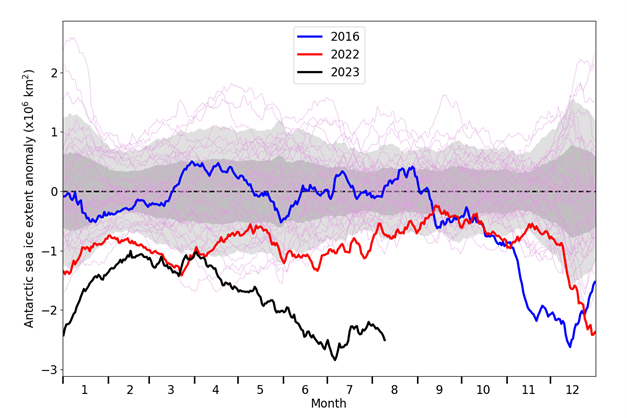
Figure 8. Daily Antarctic sea ice extent anomaly, relative to the 1981-2010 average, according to the NSIDC Sea Ice Index. 1981-2010 1x and 2x standard deviation is indicated by grey filled regions; all individual years from 1979 are indicated in light pink, with 2016 (blue), 2022 (red) and 2023 (black) highlighted.
References
Fetterer, F., K. Knowles, W.N. Meier, M. Savoie and A.K. Windnagel (2017) Sea Ice Index, Version 3. Boulder, Colorado USA. National Snow and Ice Data Center. https://doi.org/10.7265/N5K072F8. Date Accessed: 03-07-2023.
Kalnay, E., and Coauthors (1996) The NCEP/NCAR 40-Year Reanalysis Project. Bull. Amer. Meteor. Soc., 77, 437–472. https://doi.org/10.1175/1520-0477(1996)077<0437:TNYRP>2.0.CO;2
Tonboe, R., J. Lavelle, R.-H. Pfeiffer and E. Howe (2017) OSI SAF Global Sea Ice Concentration. Product OSI-401-b. Version 1.6. September 2017, Available at: https://osi-saf.eumetsat.int/products/osi-401-b
Wang, J., J. Zhang, E. Watanabe, M. Ikeda, K. Mizobata, J.E. Walsh, X. Bai and B. Wu (2009) Is the Dipole Anomaly a major driver to record lows in Arctic summer sea ice extent? Geophys. Res. Lett., 36, L05706. https://doi.org/10.1029/2008GL036706


